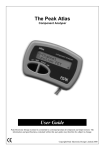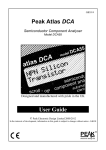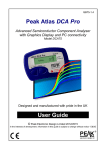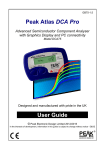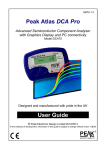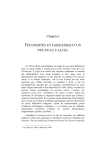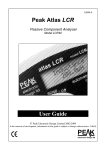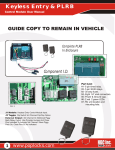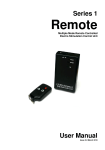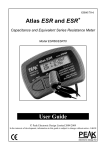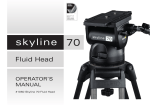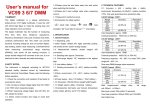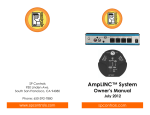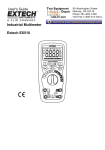Download DT-155 v100412 英文.cdr
Transcript
Intelligent Semiconductor Analyzer User Manual Please read this manual before switching the unit on. Important safety information inside. Intelligent Semiconductor Analyzer User Manual 2 Intelligent Semiconductor Analyzer User Manual Page Contents 1.Introduction ...........................................................................4 2.Important Considerations ......................................................5 3.Analysin Gsemiconductors......................................................6 3.3-1.Diodes...............................................................................6 3.3-2.Diodes Network............................................................... 7 3.3-3.LEDS.................................................................................8 3.3-4.Bicolour LEDS...................................................................9 3.3-5.Bipolar Junction Transistor................................................10 3.3-6.Transistor Special Features................................................11 3.3-7.Faulty or Very Low Gain Transistors...................................12 3.3-8.Current Gain (HFE)............................................................12 3.3-9.Base-Emitter Voltage Drop................................................13 3.3-10.Collector Leakage Current...............................................13 3.3-11.Mosfets...........................................................................14 3.3-12.Junction FETS Are conventional Field Effect Transistors...15 3.3-13.Thyristors........................................................................16 4.Battery Replacement................................................................17 3 Intelligent Semiconductor Analyzer User Manual 1.Introduction Components tester is an intelligent semiconductor analyser that offers great features together with refreshing simplicity. The Tester brings a world of component data to your fingertips. 1.Automatic component type identification •Bipolar transistors •Darlington transistors •Enhancement Mode MOSFETS •Depletion Mode MOSFETS •Junction FETS •Low power sensitive Triacs •Low power sensitive Thyristors •Light Emitting Diodes •Bicolour LEDS •Diodes •Diode networks 2.Automatic pinout identification, just connect any way round. 3.Special feature identification such as diode protection and resistor 3.shunts. 4.Gain measurement for bipolar transistors. 5.Leakage current measurement for bipolar transistors. 6.Silicon and Germanium detection for bipolar transistors. 7.Gate threshold measurement for Enhancement Mode Mosfets. 8.Semiconductor forward voltage measurement for diodes, LEDS and 3.transistor Base-Emitter junctions. 9.Automatic and manual power-off. 4 Intelligent Semiconductor Analyzer User Manual 2.Important Considerations The Tester is designed to analyse discrete, unconnected, unpowered components. This ensures that external connections don’t influence the measured parameters. The three test probes can be connected to the component any way round. If the component hasonly two terminals, then any pair of the three test probes can be used. The Tester will start component analysis when the ON/Analyse button is pressed if the unit is powered down. If the Tester is not powered down then a new analysis can be started by pressing and holding the OFF/Page, button first to power down the unit and then pressing the ON/Analyse button. Depending on the component type, analysis may take a few seconds to complete, after which, the results of the analysis are displayed. Information is displayed a “page” at a time, each page can be displayed by briefly pressing the OFF/Page button. The arrow symbol on the display indicates that more pages are available If the cannot detect any component No Component between any of the test probes, the Detected following message will be displayed: If the component is not a supported component type, a faulty component or a component that is being tested in-circuit, the analysis may result in the following message being displayed: Unknown/Faulty Component Some components may be faulty due to a shorted junction between a pair of the probes. If this is the case, the following message (or similar) will be displayed: Short Circuit On Green Blue If all three probes are shorted (or very low resistance) then the following message will be displayed: Short Circuit On Green Blue Red 5 Intelligent Semiconductor Analyzer User Manual It is possible that the Tester may detect one or more diode junctions or other component type within an unknown or faulty part. This is because many semiconductors comprise of PN (diode) junctions. Please refer to the section on diodes and diode networks for more information. 3.Analysin Gsemiconductors 3-1.Diodes The Tester will analyse almost any type of diode. Any pair of the three test clips can be connected to the diode, any way round. If the unit detects a single diode, the following message will be displayed: Pressing the OFF/Page button will then display the pinout for the diode. In this example, the Anode of the diode is connected to the Red test clip and the Cathode is connected to the Green test clip, additionally, the Blue test clip is unconnected. The forward voltage drop is then displayed, this gives an indication of the diode technology. In this example, it is likely that the diode is a silicon diode. A germanium or Schottky diode may yield a forward voltage of about 0.25V. The current at which the diode was tested is also displayed. Diode Or Diode Junction(s) Red Green Blue Anod Cath Forward Voltage Vf=0.64V Test Current If=4.38mA The Tester will determine that the diode(s) under test is an LED if the measured forward voltage drop exceeds 1.50V. Please refer to the section on LED analysis for more information. 6 Intelligent Semiconductor Analyzer User Manual 3-2.Diodes Network The Tester will intelligently identify popular types of three terminal diode networks. For three terminal devices such as SOT-23 diode networks, the three test clips must all be connected, any way round. The instrument will identify the type of diode network and then display information regarding each detected diode in sequence. The following types of diode networks are automatically recognised by the Tester: Both cathodes connected together, such as the BAV70 device. Common Cathode Diode Network Anodes of each diode are connected together, the BAW56W is an example. Common Anode Diode Network Here, each diode is connected in series. An example is the BAV99. Following the component identification, the details of each diode in the network will be displayed. Firstly, the pinout for the diode is displayed, followed by the electrical information, forward voltage drop and the current at which the diode was tested. The value of the test current depends on the measured forward voltage drop of the diode. Series diode network Pinout for D1... Red Green Blue Anod Cath Forward Voltage D2 Vf=0.64V Following the display of all the details for the first diode, the details of the second diode will then be displayed. 7 Intelligent Semiconductor Analyzer User Manual 3-3.LEDS An LED is really just a another type of diode, however, the Tester will determine that an LED or LED network has been detected if the measured forward voltage drop is larger than 1.5V. This also enables the Tester to intelligently identify bicolour LEDs, both two-terminal and three-terminal varieties. Like the diode analysis, the pinout, the forward voltage drop and the associated test current is displayed. Led Or Diode Junction(s) Here, the Cathode (-ve) LED terminal is connected to the Green test clip and the Anode (+ve) LED terminal is connected to the Blue test clip. Red Green Blue Cath Anod In this example, a simple green LED yields a forward voltage drop of 1.87V. Forward Voltage Vf=1.87V The test current is dependant on the forward voltage drop of the LED, here the test current is measured as 3.15mA. Test Current If=3.15mA Some blue LEDS (and their cousins, white LEDS) require high forward voltages and may not be detected by the Tester. 8 Intelligent Semiconductor Analyzer User Manual 3-4.Bicolour LEDS Bicolour LEDS are automatically identified. If your LED has 3 leads then ensure they are all connected, in any order. A two terminal bicolour LED consists of two LED chips which are connected in inverse parallel within the LED body. Three terminal bicolour LEDS are made with either common anodes or common cathodes. Here a two terminal LED has been detected. Two Terminal Bicolour LED This message will be displayed if the unit has detected a three terminal LED. Three Terminal Bicolour LED The details of each LED in the package will then be displayed in a similar way to the diode networks detailed earlier. Pinout for D1... The pinout for the 1st LED is displayed. Remember that this is the pinout for just one of the two LEDS in the package. Red Green Blue Anod Cath Interestingly, the voltage drops for each LED relate to the different colours within the bicolour LED. It may therefore be possible to determine which lead is connected to each colour LED within the device. Red LEDs often have the lowest forward voltage drop, followed by yellow LEDS, green LEDs and finally, blue LEDS. Forward Voltage D1 Vf=1.98V Test Current 9 Intelligent Semiconductor Analyzer User Manual 3-5.Bipolar Junction Transistor Bipolar Junction Transistors are simply "conventional" transistors, although variants of these do exist such as Darlingtons, diode protected, resistor shunted types and combinations of these types. All of these variations are automatically identified by the Tester. Bipolar Junction Transistors are available in two main types, NPN and PNP. In this example, the unit has detected a Silicon PNP transistor. The unit will determine that the transistor is Germanium only if the base-emitter voltage drop is less than 0.4V and is also PNP. If the device is a Darlington transistor (two BJTs connected together), the unit will display a similar message to this: PNP Silicon Transistor PNP Germanium Transistor NPN Darlington Transistor Pressing the OFF/Page button will result in the transistor's pinout being displayed. Here, the instrument has identified that the Base is connected to the Red test clip, the Collector is connected to the Green test clip and the Emitter is connected to the Blue test clip. 10 Red Green Blue Base Coll Emit Intelligent Semiconductor Analyzer User Manual 3-6.Transistor Special Features Many modern transistors contain additional special features. If the Tester has detected any special features, then the details of these features are displayed next after pressing the OFF/Page button. If there are no special features detected then the next screen will be the transistor’s current gain. Some transistors, particularly CRT Diode Protection deflection transistors and many large Darlingtons have a protection diode Between C-E inside their package connected between the collector and emitter. The Philips BU505DF is a typical example of a diode protected bipolar transistor. Remember that protection diodes are always internally connected between the collector and the emitter so that they are normally reverse biased. For NPN transistors, the anode of the diode is connected to the emitter of the transistor. For PNP transistors, the anode of the diode is connected to the collector of the transistor. Additionally, many Darlingtons and a few non-Darlington transistors also have a resistor shunt network between the base and emitter of the device. The Tester can detect the resistor shunt if it has a resistance of typically less than 60kΩ. The popular Motorola TIP110 NPN Darlington transistor contains internal resistors between the base and emitter. When the unit detects the presence of a resistive shunt between the base and emitter, the display will show: Additionally, the Tester will warn you that the accuracy of gain measurement (HFE) has been affected by the shunt resistor. Resistor Shunt Between B-E HFE Not Accurate Due To B-E Res 11 Intelligent Semiconductor Analyzer User Manual 3-7.Faulty or Very Low Gain Transistors Faulty transistors that exhibit very low gain may cause the Tester to only identify one or more diode junctions within the device. This is because NPN transistors consist of a structure of junctions that behave like a common anode diode Common Anode network. PNP transistors can appear Diode Network to be common cathode diode networks. The common junction represents the base terminal. This is normal for situations where the current gain is so low that it is immeasurable at the test currents used by the Tester. In some circumstances, the unit may not be able to deduce anything sensible from the device at all, in which case you will see either of these messages Unknown/Faulty Component No Component Detected 3-8.Current Gain (HFE) The DC current gain (HFE) is displayed after any special transistor features have been displayed. The gain of all transistors can vary considerably with collector current, collector voltage and also temperature. The displayed value for gain therefore may not represent the gain experienced at other collector currents and voltages. This is particularly true for large devices. Current Gain HFE=119 Test Current Ic=2.50mA Darlington transistors can have very high gain values and more variation of gain will be evident as a result of this. Additionally, it is quite normal for transistors of the same type to have a wide range of gain values. For this reason, transistor circuits are often designed so that their operation has little dependence on 12 Intelligent Semiconductor Analyzer User Manual the absolute value of current gain. The displayed value of gain is very useful however for comparing transistors of a similar type for the purposes of gain matching or fault finding. 3-9.Base-Emitter Voltage Drop The DC characteristics of the base-emitter junction are displayed, both the base-emitter forward voltage drop and the base current used for the measurement. The forward base-emitter voltage drop can aid in the identification of silicon or germanium devices. Germanium devices can have base-emitter voltages as low as 0.2V, Silicon types exhibit readings of about 0.7V and Darlington transistors can exhibit readings of about 1.2V because of the multiple base-emitter junctions being measured. B-E Voltage Vbe=0.72V Test Current IB=4.48mA 3-10.Collector Leakage Current The collector current that takes place when no base current is flowing is referred to as Leakage Current. Most modern transistor exhibit extremely low values of leakage current, often less than 1µA, even for very high collector-emitter voltages. Older Germanium types however can suffer from significant collector leakage current, particular at high temperatures (leakage current can be very temperature dependant). Leakage Current IC=0.15mA If your transistor is a Silicon type, you should expect to see a leakage current of close to 0.00mA unless the transistor is faulty. 13 Intelligent Semiconductor Analyzer User Manual 3-11.Mosfets Mosfet stands for Metal Oxide Semiconductor Field Effect Transistor. Like bipolar transistors, Mosfets are available in two main types, N-Channel and P-Channel. Most modern Mosfets are of the Enhancement Mode type, meaning that the bias of the gate-source voltage is always positive (For N-Channel types). The other (rarer) type of Mosfet is the Depletion Mode type which is described in a later section. Enhancement Mod N-Ch MOSFET Mosfets of all types are sometimes known as Igfets, meaning Insulated Gate Field Effect Transistor. This term describes a key feature of these devices, an insulated gate region that results in negligible gate current for both positive and negative gate-source voltages (up to the maximum allowed values of course, typically ±20V). The first screen to be displayed gives information on the type of Mosfet detected. Pressing OFF/Page will then result in the pinout of the Mosfet being displayed. The gate, source and drain are each identified. An important feature of a Mosfet is the gate-source threshold voltage, the gatesource voltage at which conduction between the source and drain starts. The gate threshold is displayed following the pinout information. 14 Red Green Blue Gate Drn Srce Gate Threshold Vgs=3.47V Test Current Id=2.50mA Intelligent Semiconductor Analyzer User Manual The fairly rare Depletion Mode Mosfet is very similar to the conventional Junction FET (JFET) except that the gate terminal is insulated from the other two terminals. The input resistance of these devices can typically be greater than 1000MΩ for negative and positive gate-source voltages. Depletion Mode devices are characterised by the gate-source voltage required to control the drain-source current. Depletion Mode N-CH Mosfet Modern Depletion Mode devices are generally only available in N-Channel varieties and will conduct current between it's drain and source terminals even with a zero voltage applied across the gate and the source. The device can only be turned completely off by taking it's gate significantly more negative than it's source terminal, say -10V. It is this characteristic that makes them so similar to conventional Jfets. Pressing OFF/Page will cause the pinout screen to be displayed. Red Green Blue Drn Gate Srce 3-12.Junction FETS Are conventional Field Effect Transistors The voltage applied across the gate-source terminals controls current between the drain and source terminals. N-Channel Jfets require a negative voltage on their gate with respect to their source, the more negative the voltage, the less current can flow between the drain and source. Unlike Depletion Mode Mosfets, Jfets have no insulation layer on the gate. This means that although the input resistance between the gate and source P-Channel is normally very high, the gate current Junction FET can rise if the semiconductor junction between the gate and source or between the gate and drain become forward biased. This can happen if the gate voltage becomes about 0.6V higher 15 Intelligent Semiconductor Analyzer User Manual than either the drain or source terminals for N-Channel devices or 0.6V lower than the drain or source for P-Channel devices. The internal structure of Jfets is essentially symmetrical about the gate terminal, this means that the drain and source terminals are indistinguishable by the Tester. The JFET type and the gate terminal are identified however. Drain And Source Not Identified Red Green Blue Gate 3-13.Thyristors Sensitive low power thyristors (silicon Controlled Rectifiers-scrs) and triacs that require gate currents and holding currents of less than 5mA can be identified and analysed with the Tester. Thyristor terminals are the anode, Sensitive Or Low cathode and the gate. The pinout of Power Thyristor the thyristor under test will be displayed Red Green Blue on the next press of the OFF/Page button. Gate Anod Cath Triac terminals are the MT1, MT2 (MT Sensitive Or Low standing for main terminal) and gate. Power Triac MT1 is the terminal with which gate current is referenced. Red Green Blue MT1 MT2 Gate 16 Intelligent Semiconductor Analyzer User Manual 4.Battery Replacement Tester should provide many years of service if used in accordance with this user guide. Care should be taken not to expose your unit to excessive heat, shock or moisture. Additionally, the battery should be replaced at least every 12 months to reduce the risk of leak damage. If a low battery warning message appears, immediate replacement of the battery is recommended as measured parameters may be affected. The unit may however continue to operate. Low Battery The battery can be replaced by carefully opening the Tester by removing the three screws from the rear of the unit. Take care not to damage the electronics. The battery should only be replaced with a high quality battery identical to, or equivalent to an Alkaline GP23A or MN21 12V (10mm diameter x 28mm length). 17 Intelligent Semiconductor Analyzer User Manual Intelligent Semiconductor Analyzer User Manual Rev.100505 Intelligent Semiconductor Analyzer User Manual




















